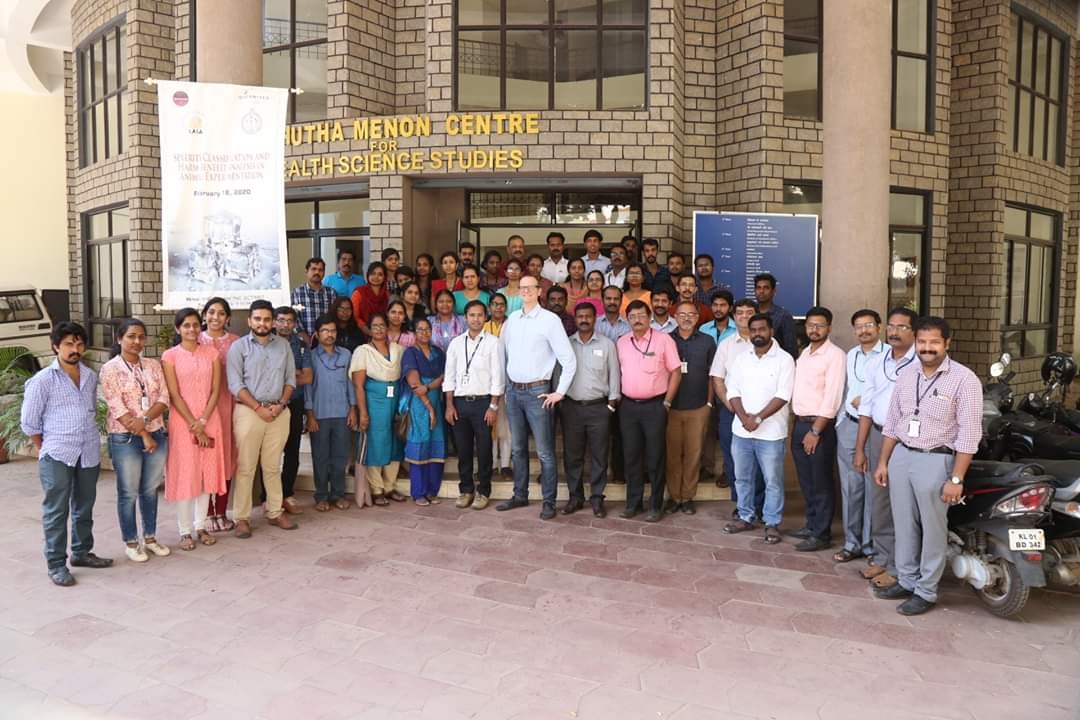The core principles, importance and scientific essence of Severity Classification and Harm Benefit Analysis in Animal Experimentation were discussed at the India Regional Workshop on the topic at Sree Chitra Tirunal Institute for Medical Sciences and Technology, Trivandrum (SCTIMST) an autonomous institution of the Department of Science and Technology (DST).
International regulations and guidelines strongly suggest that the use of animal models in scientific research should be initiated only after the authority responsible for the review of animal studies has concluded well-thought-out harm–benefit analysis (HBA). Laboratory animal veterinarians and scientific communities in India are being sensitized about the issue.
The one-day workshop on the topic organized by SCTIMST and funded by Laboratory Animal Scientists Association, India Regional workshop Grant was attended by 50 participants including Scientists, Veterinarians, CPCSEA nominees, MSc, MVSc and Ph.D. Students from organizations across the South Indian states viz Hyderabad, Bangalore, Tumkur, Padappai, Chennai, Kumaracoil, Nagerkovil, Trichur, Wayanad, Kozhikode, Kottayam, and Trivandrum.
Dr. Klas Abelson, Associate Professor at the Department of Experimental Medicine, Faculty of Health and Medicine, University of Copenhagen, Denmark lead through the sessions. The important principles of Severity classification and Harm Benefit Analysis were demonstrated to the audience and case-studies were presented. The group discussions led to a better understanding of core principles. The trainees were made aware of the importance and scientific essence to adhere to these principles and exercises.
In the European Union, Directive 2010/63/EU on the protection of animals used for scientific purposes mandatorily requires that a prospective assessment be made on the severity of each procedure in a Project and that a severity classification is assigned, which may be either “non-recovery,” “mild,” “moderate” or “severe.” Guidance on the factors to be taken into account in consideration of prospective severity is well defined.
Use of animals in research is generally accepted by policymakers through regulations, and is based on the presumption that harm–benefit analysis (HBA) warrants such use. The need to perform an HBA has been explicitly mentioned in EU Directive 2010/63,2 the Office International des Epizooties (OIE) Terrestrial Animal Code and the Council for International Organizations of Medical Sciences–International Council for Laboratory Animal Science (CIOMS–ICLAS) International Guiding Principles for Biomedical Research Involving Animals, and is implied in the NRC Guide.
The Association for Assessment and Accreditation of Laboratory Animal Care International, AAALAC has communicated its expectation to all programs participating in accreditation that an HBA based upon the EU Directive should be performed at least in some instances, and underlined advice in the NRC Guide indicating that ‘the IACUC is obliged to weigh the benefits of the study against potential animal welfare concerns.’ More widely, 178 countries participated in the World Assembly of Delegates to the World Organization for Animal Health (OIE) which recently revised the Terrestrial Animal Health Code to include harm benefit analysis under use of animals in research and education which anticipates inclusion of HBA in the national guidelines of signatory countries by agreement.
Classifying experiments in severity categories aids in the identification of harmful experiments that require extra attention or resources. Such classification systems have been developed both in Europe and in the USA. Experiments causing severe harm warrant careful evaluation and the incorporation of applicable refinements such as the selection of alternative experimental parameters of satisfactory value, early intervention and other more humane endpoints.
Such refinements can also be used as means to down-classify a specific experiment from a severe category to a moderate or mild category, with the overall goal of maximizing harm reduction in all cases as the objective in mind. Categorization also helps in the communication on how HBAs and evaluations are made in a transparent manner. These measures provide opportunities to improve the quality of science and welfare through prospective review of project proposals and, by inclusion of the actual suffering experienced by the animal, should provide greater transparency and understanding of the impact of scientific procedures on animal welfare.
The benefit is obvious from some experiments where the hypothesis presents a cure to incurable diseases or vaccines to diseases like Novel Corona Virus. Here, we can sanction experiments, but still, by learning nuances of Humane Endpoint assessment, we can minimize the harm caused to animals and yet get the full benefit out of using them.
There is consensus that sentience and ability to suffer are relevant. There is also agreement that harm is more than pain and suffering, and includes all sources that can cause negative impact on animals, and harms can be related to all domains provided by the five freedoms. Several models for comparing and weighing harm– benefits were presented. Animal experiments can be simply categorized as ‘low harm–high benefit’, ‘low benefit–high harm’, ‘low harm–low benefit’ or ‘high harm–high benefit’.
The low harm–high benefit experiments elicit minimal controversy. Although there are ways to grade harm and benefit presented both here and by others, there is no common ‘currency’ or value system for comparing the different realms of harm and benefit. Therefore, HBA remains intractably context-dependent. When implementing HBA the responsible entities should be represented by different stakeholders to give a balanced evaluation and a group consensus should be the desired outcome.
The teacher of the course explained in depth the advantages and techniques to implement this in real work situations taking example from his Scientific background. Science can be better, and animal experiments can be harmonized and resources best utilized by adapting to these core principles while judiciously planning or evaluate experimentation protocols. Several faculties, technical staff, and students from SCTIMST attended the training.































